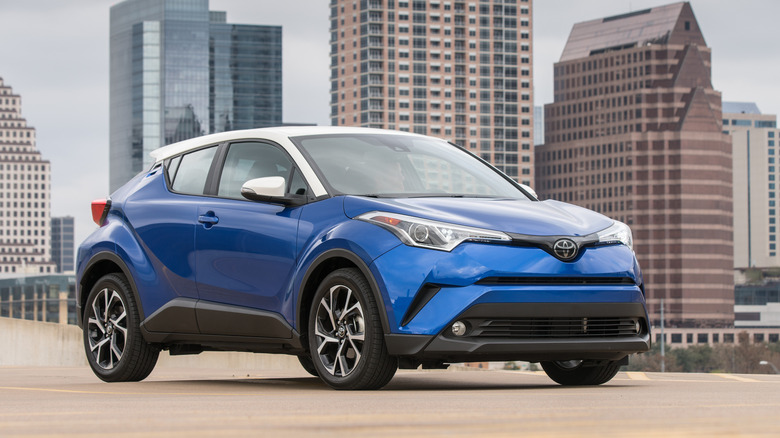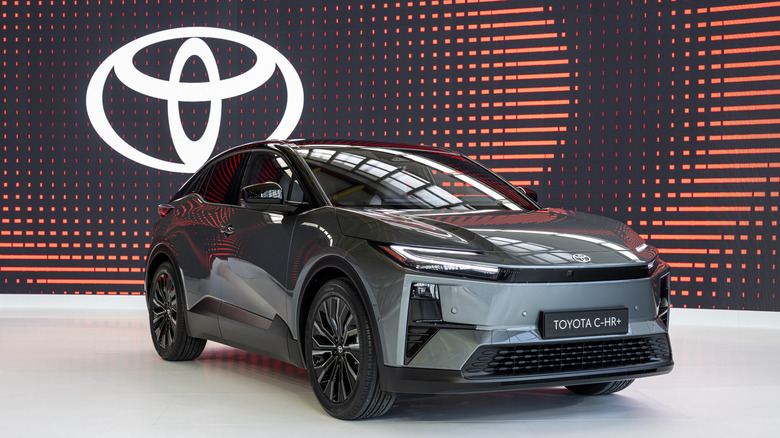Why Toyota Discontinued The C-HR In The US After 5 Years
The Toyota C-HR ("C-HR" stood for "Compact High-Rider") was only around for five total years, starting production in 2017 and ending in 2022. Overall, the reasons for its departure don't require a lot of detective work. Perhaps the biggest nail in the C-HR's coffin was its sales numbers. In 2022, the final model year, Toyota sold 12,141 C-HR's down a total of 66 percent from the previous year's 35,707 cars sold. Worse yet is how it compared to other Toyotas. In 2022, Toyota sold 399,941 RAV4s.
A sales disaster may have been the reason why the C-HR was axed from a business perspective. However, plenty of cars become cult classics after failing at the dealership after the public discovers the car wasn't really that bad. That isn't really the case with the C-HR. It really wasn't that good of a model to begin with. It wasn't unreliable or dangerous to be clear, it's just unclear what Toyota was trying to do with the car and a few of its design and mechanical components are less than stellar, to put it politely.
Not all that inspiring
Looking at the C-HR, you will immediately notice one thing: it looks funky. It's way funkier than the normally very safely styled Toyota. That's because it was originally intended to be a Scion, Toyota's former youth-centric "hipper" brand. At the 2015 Los Angeles Auto Show, Toyota showed off what was then called the Scion C-HR. From original concept sketches it was supposed to be a hybrid and according to a Scion press conference, it was supposed to be available as a six-speed manual. Fast forward to 2017, Scion is no more, and Toyota launches the C-HR for the 2018 model year. The resulting car was uninspiring mechanically with a 144 horsepower 2.0-liter four cylinder and a CVT. Perhaps most confusingly is the total lack of all-wheel drive, something that would be expected in an SUV (or at least vaguely SUV-shaped vehicle). Still, it was new and wacky, so it's possible Toyota thought that it might persuade some new buyers. After all, the Chrysler PT Cruiser initially sold extremely well.
Additionally, the C-HR was firmly "adequate" when it came to fuel economy. It averaged 29 miles per gallon thanks in part to its weak engine and CVT. Comparatively, an all-wheel drive 2018 RAV4 averaged 25 miles per gallon. It was outclassed entirely by the 32 miles per gallon 2018 Camry and hybrid models like the 2018 Prius leave it in the dust at 52 miles per gallon.
The C-HR's future in Europe
The C-HR was oddly styled, poorly equipped mechanically, and not particularly thrifty when it came to fuel. Throw all that together with a total sales failure, and you can see why Toyota decided that 2022 was the last year for the C-HR's time in the United States.
However, the C-HR has not entirely faded into obscurity, and it actually might see a new life in Europe as an electric car. According to a press release from Toyota Europe, the C-HR+ is an electric crossover SUV (with an all-wheel drive option!), and a proposed range of 600 kilometers (372 miles) through its optional 77 kilowatt hour battery. Toyota hasn't announced the price yet for the European market, but if the price is realistic, then that's definitely a huge jump in the right direction to redeem the C-HR's name. It's supposed to launch toward the end of 2025.
The C-HR didn't make waves in the United States, proving to be more of an odd sales mistake than a hip, funky car like it was originally envisioned to be. But the future looks a little brighter for the model overseas. It just needed a little bit of electrification.


